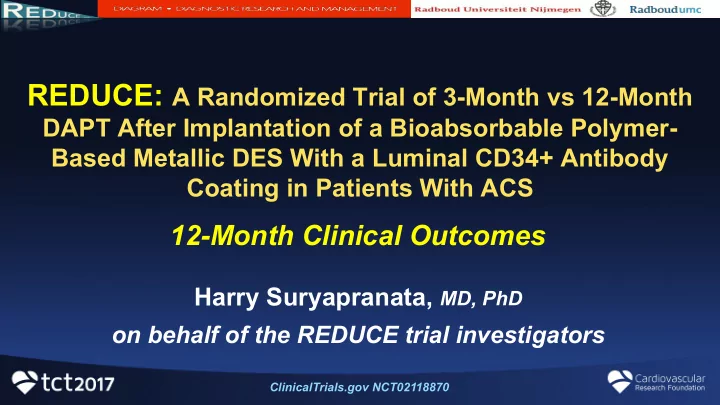

REDUCE: A Randomized Trial of 3-Month vs 12-Month DAPT After Implantation of a Bioabsorbable Polymer- Based Metallic DES With a Luminal CD34+ Antibody Coating in Patients With ACS 12-Month Clinical Outcomes Harry Suryapranata, MD, PhD on behalf of the REDUCE trial investigators ClinicalTrials.gov NCT02118870
Background • Short-term DAPT reduces bleeding rates, without increasing thrombotic complications (1-2) . Therefore, recent guidelines recommend 6-12 months DAPT for patients with stable angina treated with new generation DES (3) • The optimal duration of DAPT in ACS patients treated with DES is still unclear, especially in the era of new anticoagulants/antiplatelet agents • The COMBO Dual Therapy Stent, which combines abluminal release of sirolimus (to prevent neointima formation) and capture of Endothelial Progenitor Cells (to enhance stent re-endothelialization) (4) may be attractive in the context of ACS 1. Navarese et al. BMJ 2015;350:h1618 2. Palmerini et al. Lancet 2015; 385: 2371-82 3. Windecker et.al. Eurintervention 2015;10:1024-9 4. Granada et al. Circ Cardiovasc Interv 2010;3:257-266
Methods • Design: Investigator-initiated, prospective, multicenter, randomized study with two randomization groups (3 vs 12 months DAPT) (NCT02118870) • Objective: To evaluate the non-inferiority of a combined safety and efficacy endpoint of a short-term 3 months DAPT, compared to standard 12-month DAPT strategy, in ACS patients treated with the COMBO stent • Primary Endpoint: Composite of all cause death, MI, ST, stroke, TVR or bleeding (BARC II, III, V) • Secondary Endpoints: - Pre-specified Landmark Analysis of Primary Endpoint from 3 to 12 month - Individual components of the composite endpoint
Results: Flow Chart 1,500 ACS patients enrolled between June 2014 and May 2016 in 36 clinical sites in Europe and Asia IC withdrawal soon after randomization (n=4) 1,496 patients were randomly assigned 3 month DAPT (n=751) 12 month DAPT (n=745) Clinical follow-up at 12 Clinical follow-up at 12 months in 98.5 % (n=734) months in 97.1 % (n=729)
Results: Primary Study Endpoint % Days 3M DAPT 12M DAPT 3 month DAPT 12 month DAPT Risk Upper bound of 1 Analysis set OR (95% CI) P non-inferiority difference sided 97.5% CI n = 729 n = 734 8.2 8.4 Inten%on to treat <0.001 -0.002 0.027 0.97 (0.67-1.41) Confirmed by PP and AT analyses, and after adjustment for gender (adjusted OR (95% CI) = 0.95 (0.66–1.38), p=0.81)
Results: Secondary Study Endpoints 3 Months DAPT 12 Months DAPT 7 % % 6 5 p = 0.35 p = 0.54 4 p = 0.57 3.4 3.3 p = 0.07 3.0 3 2.5 p = 0.08 2.3 1.9 * p = 0.13 1.9 p = 1.00 2 1.2 1.1 0.8 1 0.4 0.4 0.4 0.3 0 All cause Cardiac Myocardial Stent Stroke TVR Bleeding mortality mortality infarction thrombosis * half of deaths caused by cancer No difference in any individual secondary endpoint
Results: Subgroup Analysis Consistent results across all subgroups, without any significant statistical interaction
Conclusion • The REDUCE trial is the first study restricted to ACS patients, comparing a short 3-month vs a standard 12-month DAPT • The main finding of the present study: Among ACS patients treated with the COMBO stent, 3-month DAPT is not inferior to 12-month DAPT • This finding is consistent for all pre-specified subgroups • Therefore, a shorter DAPT strategy could be considered, if necessary, even in ACS population • Future larger trials are needed to further investigate and confirm the safety of short-term DAPT regimen in ACS patients in the era of new ADP antagonists and new generation DES
Recommend
More recommend